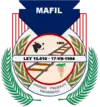Máfil
Máfil (Mapudungun for embraced between rivers) is a town and commune of the Valdivia Province, Los Ríos Region in southern Chile, about 30 km northeast of Valdivia. The main economic aticivities of Máfil are forestry, cattle farming, cultivation and gold and coal mining the Madre de Dios and Mulpún areas. Its population was 7,213 persons per the 2002 census.
Máfil | |
|---|---|
 Flag  Coat of arms  Location of the Commune of Máfil  Máfil Location in Chile | |
| Coordinates: 39°39′S 72°57′W | |
| Country | Chile |
| Region | Los Rios |
| Province | Valdivia |
| Founded | 17 July 1964 |
| Government | |
| • Type | Municipality |
| • Alcalde | Moira Henzi Becker |
| Area | |
| • Total | 582.7 km2 (225.0 sq mi) |
| Elevation | 14 m (46 ft) |
| Population (2012 Census)[2] | |
| • Total | 7,006 |
| • Density | 12/km2 (31/sq mi) |
| • Urban | 3,796 |
| • Rural | 3,417 |
| Sex | |
| • Men | 3,773 |
| • Women | 3,440 |
| Time zone | UTC-4 (CLT [3]) |
| • Summer (DST) | UTC-3 (CLST [4]) |
| Area code(s) | 56 + 63 |
| Website | Municipality of Máfil |
Demographics
According to the 2002 census of the National Statistics Institute, Máfil spans an area of 582.7 km2 (225 sq mi) and has 7,213 inhabitants (3,773 men and 3,440 women). Of these, 3,796 (52.6%) lived in urban areas and 3,417 (47.4%) in rural areas. The population fell by 7% (547 persons) between the 1992 and 2002 censuses.[2]
Administration
As a commune, Máfil is a third-level administrative division of Chile administered by a municipal council, headed by an alcalde who is directly elected every four years.The 2008-2012 alcalde is Moira Henzi Becker.[1]
Within the electoral divisions of Chile, Máfil is represented in the Chamber of Deputies by Mr. Alfonso De Urresti (PS) and Mr. Roberto Delmastro (RN) as part of the 53rd electoral district, (together with Valdivia, Lanco, Mariquina and Corral). The commune is represented in the Senate by Andrés Allamand Zavala (RN) and Eduardo Frei Ruiz -Tagle (PDC) as part of the 16th senatorial constituency (Los Ríos Region).
References
- "Municipality of Máfil" (in Spanish). Archived from the original on 17 April 2003. Retrieved 13 December 2010.
- "National Statistics Institute" (in Spanish). Retrieved 13 December 2010.
- "Chile Time". WorldTimeZones.org. Archived from the original on 13 July 2010. Retrieved 26 September 2010.
- "Chile Summer Time". WorldTimeZones.org. Archived from the original on 11 September 2007. Retrieved 26 September 2010.
External links
- (in Spanish) Municipality of Máfil
